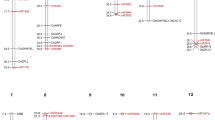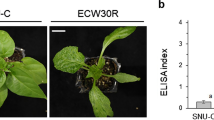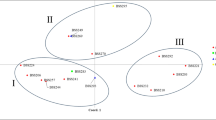Abstract
With a long-term goal of constructing a linkage map enriched with gene-specific markers in rubber tree (Hevea brasiliensis Muell. Arg.), we utilized rubber tree ESTs associated with tapping panel dryness (TPD) to develop intron-flanking PCR markers. After downloading and assembling the rubber tree ESTs associated with TPD, we predicted the exon/exon junction sites (E/E) by aligning rubber tree transcripts with the genomic sequences of castor bean (Ricinus communis L.). Based on the predicted E/E, the primers flanking intron(s) and no intron were designed. Compared with the markers designed by conventional method, the PCR success rate of the markers designed with the predicted E/E increased 28-30%, whereas the polymorphism rate of intron-flanking EST-PCR markers was approximately 3.43-fold increase. Therefore, the intron-flanking marker was more polymorphism-generating efficient than the markers designed by conventional methods. In addition, analyzing the polymorphic information content (PIC) among Hevea germplasm showed that the polymorphism of wild rubber tree accessions was higher than one of cultivated rubber tree clones and Hevea species. This study enriches the categories and numbers of molecular markers in rubber tree, and the markers developed in this research will have a wide application in DNA fingerprinting, marker-assisted selection and genetic mapping in rubber tree. This research also indicates that it is possible to develop intron-flanking EST-PCR markers of rubber tree with castor bean genome as reference sequences, which provides new insights into developing intron-flanking EST-PCR markers for rubber tree or other plant species without genomic information.



Similar content being viewed by others
References
Cataldo, F. (2000). Guayule rubber: a new possible world scenario for the production of natural rubber. Progress in Rubber and Plastics Technology, 16, 31–59.
Cornish, K. (2001). Similarities and differences in rubber biochemistry among plant species. Phytochemistry, 57, 1123–1134.
Jiang, J. S., & Zhou, Z. Y. (1997). Prospects of science and technology for natural rubber in China. Chinese Journal of Tropical Crops, 21, 1–7.
Varghese, Y. A., Knaak, C., Sethuraj, M. R., & Ecke, W. (1997). Evaluation of random amplified polymorphic DNA (RAPD) markers in Hevea brasilinesis. Plant Breeding, 116, 47–52.
Venkatachalam, P., Thomas, S., Priya, P., Thanseem, I., Gireesh, T., Saraswathyamma, C. K., et al. (2002). Identification of DNA polymorphism with the cultivated clones of rubber tree (Hevea brasiliensis Muell. Arg.). Indian Journal of Natural Rubber Research, 15, 72–181.
Venkatachalam, P., Priya, P., Saraswathyamma, C. K., & Thulaseedharan, A. (2004). Identification, cloning and sequence analysis of a dwarf genome-specific RAPD marker in rubber tree Hevea brasiliensis Muell. Arg. Plant Cell Reports, 23, 327–332.
Venkatachalam, P., Priya, P., Gireesh, T., Saraswathyamma, C. K., & Thulaseedharan, A. (2006). Molecular cloning and sequencing of a polymorphic band from rubber tree [Hevea brasiliensis (Muell.) Arg.]: The nucleotide sequence revealed partial homology with proline-specific permease gene sequence. Current Science, 90, 1510–1515.
Lespinasse, D., Rodier-Goud, M., Grivet, L., Leconte, A., Legnaté, H., & Seguin, M. (2000). A saturated genetic linkage map of rubber tree (Hevea spp.) based on RFLP, AFLP, microsatellite and isozyme markers. Theoretical and Applied Genetics, 100, 127–138.
Lespinasse, D., Grivet, L., Troispoux, V., Rodier-Goud, M., Pinard, F., & Seguin, M. (2000). Identification of QTLs involved in the resistance to South American leaf blight (Microcyclus ulei) in the rubber tree. Theoretical and Applied Genetics, 100, 975–984.
Besse, P., Seguin, M., Lebrun, P., & Lanaud, C. (1993). Ribosomal DNA variations in wild and cultivated rubber tree (Hevea brasiliensis). Genome, 36, 1049–1057.
Besse, P., Lebrun, P., Seguin, M., & Lanaud, C. (1993). DNA fingerprints in Hevea brasiliensis (rubber tree) using human minisatellite probes. Heredity, 70, 237–244.
Besse, P., Seguin, M., Lebrun, P., Chevallier, M. H., Nicolas, D., & Lanaud, C. (1994). Genetic diversity among wild and cultivated populations of Hevea brasiliensis assessed by nuclear RFLP analysis. Theoretical and Applied Genetics, 88, 199–207.
Luo, H., & Boutry, M. (1995). Phylogenetic relationships within Hevea brasiliensis as deduced from a polymorphic mitochondrial DNA region. Theoretical and Applied Genetics, 91, 876–884.
Luo, H., van Coppenolle, B., Seguin, M., & Boutry, M. (1995). Mitochondrial DNA polymorphism and phylogenetic relationships in Hevea brasiliensis. Molecular Breeding, 1, 51–63.
Low, F. C., Atan, S., Jaafar, H., & Tan, H. (1996). Recent advances in the development of molecular markers for Hevea studies. Journal of Natural Rubber Research, 11, 32–44.
Atan, S., Low, F. C., & Saleh, N. M. (1996). Construction of a microsatellite enriched library from Hevea brasiliensis. Journal of Natural Rubber Research, 11, 247–255.
Bindu Roy, C., Nazeer, M. A., & Saha, T. (2004). Identification of simple sequence repeats in rubber (Hevea brasiliensis). Current Science, 87, 807–811.
Saha, T., Roy, B., & Nazeer, M. A. (2005). Microsatellite variability and its use in the characterization of cultivated clones of Hevea brasiliensis. Plant Breeding, 124, 86–92.
Hua, Y. W., Lu, Y., Long, Q. Y., Zeng, X., Hu, Y. S., & Huang, H. S. (2008). Development of EST-SSRs using public ESTs in Hevea. Chinese Journal of Tropical Crops, 5, 583–588.
An, Z. W., Zhao, Y. H., Cheng, H., Li, W. G., & Huang, H. S. (2009). Development and application of EST-SSR markers in Hevea brasiliensis Muell. Arg. Hereditas, 31(3), 311–319.
Feng, S. P., Li, W. G., Huang, H. S., Wang, J. Y., & Wu, Y. T. (2009). Development, characterization and cross-species/genera transferability of EST-SSR markers for rubber tree (Hevea brasiliensis). Molecular Breeding, 23, 85–97.
Small, R. L., & Wendel, J. F. (2000). Phylogeny, duplication, and intraspecific variation of Adh sequences in new world diploid cottons (Gossypium L., Malvaceae). Molecular Phylogenetics and Evolution, 16, 73–84.
Zhang, D. X., & Hewitt, G. M. (2003). Nuclear DNA analyses in genetic studies of populations: practice, problems and prospects. Molecular Ecology, 12, 563–584.
Bierne, N., Lehnert, S. A., Be′dier, E., Bonhomme, F., & Moore, S. S. (2000). Screening for intron-length polymorphisms in penaeid shrimps using exon-primed intron-crossing (EPIC)-PCR. Molecular Ecology, 9, 233–235.
Hassan, M., Lemaire, C., Fauvelot, C., & Bonhomme, F. (2002). Seventeen new exon-primed intron-crossing polymerase chain reaction amplifiable introns in fish. Molecular Ecology Notes, 2, 334–340.
Wang, X. S., Zhao, X. Q., Zhu, J., & Wu, W. R. (2005). Genome-wide investigation of intron length polymorphisms and their potential as molecular markers in rice (Oryza sativa L.). DNA Research, 12, 417–427.
Yang, L., Jin, G. L., Zhao, X. Q., Zheng, Y., Xu, Z. H., & Wu, W. R. (2007). PIP: A database of potential intron polymorphism markers. Bioinformatics, 23, 2174–2177.
Choi, H. K., Kim, D., Uhm, T., Limpens, E., Lim, H., Mun, J. H., et al. (2004). A sequence-based genetic map of Medicago truncatula and comparison of marker colinearity with M. sativa. Genetics, 166, 1463–1502.
Wei, H., Fu, Y., & Arora, R. (2005). Intron-flanking EST-PCR markers: From genetic marker development to gene structure analysis in Rhododendron. Theoretical and Applied Genetics, 111(7), 1347–1356.
Wang, Y., Chen, J., Francis, D. M., Shen, H., Wu, T., & Yang, W. (2010). Discovery of intron polymorphisms in cultivated tomato using both tomato and Arabidopsis genomic information. Theoretical and Applied Genetics, 121, 1199–1207.
Pashley, C. H., Ellis, J. R., McCauley, D. E., & Burke, J. M. (2006). EST databases as a source for molecular markers: lessons from Helianthus. Journal of Heredity, 97(4), 381–388.
Venkatachalam, P., Thulaseedharan, A., & Raghothama, K. G. (2007). Identification of expression profiles of tapping panel dryness (TPD) associated genes from the latex of rubber tree (Hevea brasiliensis Muell. Arg). Planta, 226, 499–515.
Li, D. J., Deng, Z., Chen, C. L., Xia, Z. H., Wu, M., He, P., et al. (2010). Identification and characterization of genes associated with tapping panel dryness from Hevea brasiliensis latex using suppression subtractive hybridization. BMC Plant Biology., 10, 140.
Rozen, S., & Skaletsky, H. J. (2000). Primer3 on the WWW for general users and for biologist programmers. In Bioinformatics methods and protocols: Methods in molecular biology (pp. 365–386). Totowa, NJ: Humana Press.
Doyle, J. J., & Doyle, J. L. (1990). Isolation of plant DNA from fresh tissue. Focus, 12, 13–15.
Anderson, J. A., Churchill, G. A., Autroque, J. E., Tanksley, S. D., & Sorrells, M. E. (1993). Optimizing parental selection for genetic linkage maps. Genome, 36, 181–186.
Milbourne, D., Meyer, R., Bradshow, J. E., Baird, E., Bonar, N., Powel, J. W., et al. (1997). The utility of RFLP, RAPID, AFLP and SSR (microsatellite) markers for germplasm analysis. Molecular Breeding, 3, 225–238.
Chen, S. C., Peng, S. Q., Huang, G. X., Wu, K. X., Fu, X. H., & Chen, Z. Q. (2002). Association of decreased expression of a Myb transcription factor with the TPD (tapping panel dryness) syndrome in Hevea brasiliensis. Plant Molecular Biology, 51, 51–58.
Venkatachalam, P., Thulaseedharan, A., & Raghothama, K. G. (2009). Molecular identification and characterization of a gene associated with the onset of tapping panel dryness (TPD) syndrome in rubber tree (Hevea brasiliensis Muell.) by mRNA differential display. Molecular Biotechnology, 41, 42–52.
Temesgen, B., Brown, G. R., Harry, D. E., Kinlaw, C. S., Sewell, M. M., & Neale, D. B. (2001). Genetic mapping of expressed sequence tag polymorphism (ESTP) markers in loblolly pine (Pinus taeda L.). Theoretical and Applied Genetics, 102, 664–675.
Wu, J., Maehara, T., Shimokawa, T., Yamamoto, S., Harada, C., Takazaki, Y., et al. (2002). A comprehensive rice transcript map containing 6591 expressed sequence tag sites. Plant Cell, 14, 525–535.
Harry, D. E., Temesgen, B., & Neale, D. B. (1998). Codominant PCR-based markers for Pinus taeda developed from mapped cDNA clones. Theoretical and Applied Genetics, 97, 327–336.
Plomion, C., Hurme, P., Frigerio, J. M., Ridolfi, M., Pot, D., Pionneau, C., et al. (1999). Developing SSCP markers in two Pinus species. Molecular Breeding, 5, 21–31.
Cato, S. A., Gardner, R. C., Kent, J., & Richardson, T. E. (2001). A rapid PCR-based method for genetically mapping ESTs. Theoretical and Applied Genetics, 102, 296–306.
Rowland, L. J., Mehra, S., Dhanaraj, A. L., Ogden, E. L., Slovin, J. P., & Ehlenfeldt, M. K. (2003). Development of EST-PCR markers for DNA fingerprinting and genetic relationship studies in blueberry (Vaccinium, section Cyanococcus). Journal of the American Society for Horticultural Science, 128, 682–690.
Gouvêa, L. R. L., Rubiano, L. B., Chioratto, A. F., Zucchi, M. I., & Gonçalves, P. S. (2010). Genetic divergence of rubber tree estimated by multivariate techniques and microsatellite markers. Genetics and Molecular Biology, 33, 308–318.
Scott, K. D., Eggler, P., Seaton, G., Rossetto, M., Ablett, E. M., Lee, L. S., et al. (2000). Analysis of SSRs derived from grape ESTs. Theoretical and Applied Genetics, 100, 723–726.
Eujayl, I., Sorrells, M., Baum, M., Wolters, P., & Powell, W. (2001). Assessment of genotypic variation among cultivated durum wheat based on EST-SSRs and genomic SSRs. Euphytica, 119, 39–43.
Acknowledgments
This research was supported by Ministry of Agriculture Opening Project Fund of Key Laboratory of Rubber Biology/State Key Laboratory Breeding Base of Cultivation & Physiology for Tropical Crops (KLOF1103), National Natural Science Foundation of China (30960310), Fundamental Research Funds for Rubber Research Institute, CATAS (1630022011024), Natural Science Foundation of Hainan Province (310072), and Modern Agricultural Industry R&D System of China (nycytx-34-GW1-2). We also thank the National Rubber Tree Germplasm Repository, Rubber Research Institute, CATAS to provide all the Hevea germplasm.
Author information
Authors and Affiliations
Corresponding authors
Additional information
Dejun Li and Zhihui Xia contributed equally to this work.
Rights and permissions
About this article
Cite this article
Li, D., Xia, Z., Deng, Z. et al. Development and Characterization of Intron-Flanking EST-PCR Markers in Rubber Tree (Hevea brasiliensis Muell. Arg.). Mol Biotechnol 51, 148–159 (2012). https://doi.org/10.1007/s12033-011-9449-8
Published:
Issue Date:
DOI: https://doi.org/10.1007/s12033-011-9449-8




